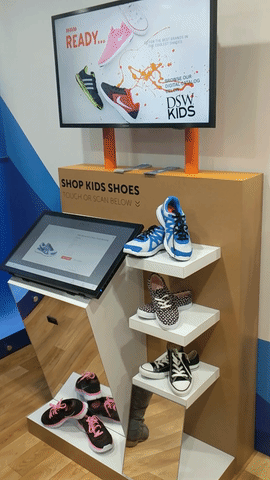Experiencing the Customer Journey Experience, National Retail Federation 2017

Oh, Flux.
Last year I found myself saying things like "there is no normal any longer" and "we are in flux, the old rules don't apply anymore."
And I was talking about retail.
When I attended the National Retail Federation's Big Show (#NRF17) this year, I didn't know what to expect. In recent years, as the show has become more and more a technology show, we saw lots of "solutions" looking for problems. The holographic product display that looked like something from the black light room at the back of Spencer's Gifts was one of my favorites.
I went in with an open mind. I was pleasantly surprised by the minimal use of "omnichannel" in booths and presentations, but disconcerted by the indiscriminate use of "experience" and "customer journey". There seemed to be little demonstration of how a particular offer is connected to consumer behavior.
All of that said, some themes are emerging that give me confidence that the art and science of retail are getting closer to being collaborative partners rather than just being in the same balance sheet.
Focus on People
At a time when executive and operational leadership is looking to technology to create value and efficiency, I thought it interesting that the NRF launches an initiative intended to help “people acquire the skills needed to secure jobs in retail and advance into promising careers, regardless of education, background, economic means or age.”
Will the pay be enough to live on?
“We have to embrace new thinking to meet the demands of this new workplace,” says Bill Brand, president of HSN said. “We must experiment.” And, he said, “we must collaborate.”
I hope the position and influence of NRF and the top retailers involved in RiseUp continue beyond mere “education and credentialing” (as stated in the NRF announcement) and work to raise the profile of retail work—both in pay and prestige.
Training and empowering frontline staff to deliver highly skilled, thoughtful customer service goes a long way to ensuring quality customer experiences.
Cognitive Technologies
The holy grail of web-like efficiency and analytics in our stores seems to be coming into focus. Cognitive technology—as defined by IBM’s Watson—is a combination of various artificial intelligence and analytical technologies that promises to give structure to unstructured data and in turn make it more understandable and usable.
I’ve seen Watson in action in both demonstrations and practical application. It’s still jenky but if we think about it as an almost infinite Swiss Army knife-like tool and use it creatively, I think it holds promise.
On a much more practical level, we’re seeing the emergence of Chatbots. Think of FAQs or automated natural language customer service you might have with your airline or credit card, but in an SMS/MMS messaging format. We’re seeing the first experiments of this on the Facebook Messenger platform. One service, Mode.ai as featured in the NRF Innovation Lab, promises to let customers:
“…find visually similar items, get styling suggestions (‘wear it with’), experience VR (‘show it on me’) and more, using computer vision, AI and deep learning.”
That’s a lot to promise. When I put it through it’s paces by searching for a men’s navy blue shawl collar sweater in XXL, the results weren’t even close to what I could find with the same search on Google or Amazon. It returned just five choices (selection is a retail imperative, duh) only one of which had a shawl collar; and that didn’t come in navy or my size. All the other choices were v-necks. No thanks, I have more than enough v-necks. Test it yourself here: www.mode.ai.
As stated in the video linked above, cognitive technologies can do the heavy lifting of using data to make informed decisions but they have a long way to go to make these valuable to retailers and seamless for consumers. I do think when we learn to design this into customer experiences we’ll really have re-written the rules of retail.
Bundled Technology and Services

Is "architeting" a verb?
Many companies are offering bundled technology and managed services as a way of getting to the benefits of the shifting ground of retail. So, it’s no longer about a POS system, a digital signage system, an endless aisle system or beacons. It’s more about how to harness and scale a combination of technologies that’s configured for a particular retailer and customer base. We may even see different configurations from store-to-store within a chain.
Samsung uses the Internet of Things concept to demonstrate their growing ecosystem. As described in fine detail in this article from The BarCode News, the fictional customer journey involves the store mobile app, a Galaxy smartphone, beacons, digital signage with personal content (!), staff-worn Gear S2 watch and tablets, mobile payments and lots of data collected along the way. It’s an interesting read. It holds possibilities if you think of it as inspiration and not prescription.
iQmetrix showed examples of customer-facing technology being deployed in DSW and telco stores featuring Samsung accessories. These bring together fixture design, digital signage and endless aisle capabilities in attractive packages.


Most know that the big ideas presented at a trade show are intended to generate media buzz and interest from potential customers, so it was nice to see things that we can actually see working.
Localization & Personalization
The benefit of all this technology and the services that go along with it, is to make our retail operations work better for staff and customers. We can see how stores won’t be so cookie cutter and defined simply by their transaction data. We may even be seeing the advent of customers’ personal preferences defining how retailers and brands localize their stores, merchandise assortment and associated services.
IBM used the notion of bringing web-like digital merchandising techniques such as in-depth product information, reviews and suggestive selling as examples of personalization. For anyone who has run a store department or bought a high-consideration item like a refrigerator or a good suit, you know these are the things any good retail sales person delivers on a daily basis. The potential to arm solid sales staff with robust, refined information is enormous.
Volumental is an intriguing example of personalization technology that has the potential for consumers to own their data and get the best possible products and services for their particular needs. In their own words:

“The Volumental solution is a hardware and software bundle that helps you digitize the fitting process with your customers and at the same time create valuable data for merchandising, product development, and marketing. Your customer steps on the scanner, and in a few seconds a tablet displays 3D models of both their feet, including the key measurements for a good shoe fit recommendation. This makes the fitting process more efficient and enjoyable.”
And, in discussing the benefits with representatives at the NRF Innovation Lab, the data that comes from more accurate sizing has fit and style implications for consumers and the potential to influence manufacturing and distribution.
Imagine having your (and your growing childrens’) precise measurements on-hand and ordering precise sizes, fulfilled by just-in-time manufacturing. This could lead to increased satisfaction, reduction of returns and waste and increased efficiency all along the supply chain.
The Results of Flux
So yes, we are in flux. The notion of normal is evolving as technology matures, consumers gain more and more control and online and in-line retail environments converge. If retailers focus on their people in addition to taking advantage of emerging technologies and techniques they may be part of re-writing the rules of retail.
Chuck Palmer is a retail strategist working at the convergence of consumer behavior, technology and innovation. He has worked with JPMorgan Chase, Airstream, Macy’s, Crate & Barrel, Nintendo, and The Home Depot among others. Chuck is a regular presenter at retail events and contributor to industry publications. Find him at @cxchuck and www.ConsumerXretail.com.

















